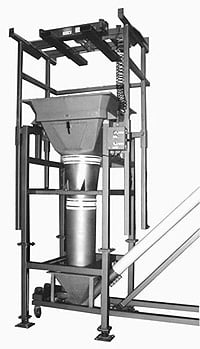A major Caribbean beverage producer - juices, soft drinks, etc. - wanted to improve productivity related to sugar handling.
Their current process involved manually breaking 50 Kg bags at multiple locations. Not only was this labor intensive, but it was soon to be a bottleneck that would impede planned increases in production output.
Working with their primary sugar supplier, one of the largest sugar brokers in the region, and Control and Metering, the beverage company created a plan to achieve their productivity goals and increase the scale of their sugar handling to meet higher production rates by changing incoming sugar packaging to big bags and designing a new sugar batching system.
Big Bags versus Small Bags
Handling sugar required six operators continuously breaking and dumping 50 Kg bags at three locations.
Plus, the 50 Kg bags had to be unloaded from shipping containers one bag at a time and placed in storage manually. This also required multiple operators.
Converting to big bags would allow container unloading to be performed by one operator with a forklift.
Instead of six operators breaking bags at three locations, current production and planned growth for the next two years could be managed by one operator and two automated big bag batching stations.
Batching Sugar from Big Bags
The big bag sugar batching systems were designed to precisely convey sugar to syrup mixing tanks to produce standard brix syrup that would be pumped to all of the beverage production lines in the plant.
Each big bag batching system included a Control and Metering F60 monorail big bag discharger, an incline screw conveyor and an automated batch weighing control system.
discharger, an incline screw conveyor and an automated batch weighing control system.
Big bags would be moved to the production area and the single sugar batching operator would move individual big bags to each of the two big bag batching stations using a pallet truck. The big bag would then we rigged to a lifting frame and placed into the F60 big bag discharger using an integral hoist and trolley.
 The operator would then safely open the big bag outlet spout within the F60 hopper to initiate sugar flow and, by pressing a single button on the control panel, start the batch.
The operator would then safely open the big bag outlet spout within the F60 hopper to initiate sugar flow and, by pressing a single button on the control panel, start the batch.
The automated batch weighing system would then control the conveying of sugar from the big bag to the syrup mixing tank according to the syrup recipe.
control the conveying of sugar from the big bag to the syrup mixing tank according to the syrup recipe.
Economic Benefit of Converting from Small Bags to Big Bags
The fully benefited labor rate at this location is $2.72 USD per hour. Even at this relatively low rate (compared to North America and elsewhere), first year labor savings were calculated to be $152,000 USD with second year savings of $196,000 USD based on increased production.
This resulted in a simple payback for the project of only 21 months. Clearly, the ROI on this project was very attractive!
For more information contact Don@ControlandMetering.com.

 Recently, we engaged with a customer that a few years ago had spent over $2 million with another vendor on an 18 station, automated bulk bag batching system. Depending on the recipe some or all of the 18 different ingredients are simultaneously metered onto a common belt conveyor for transfer to one of two mixers. Each station dispenses its ingredient in specific batch weights according to the recipe.
Recently, we engaged with a customer that a few years ago had spent over $2 million with another vendor on an 18 station, automated bulk bag batching system. Depending on the recipe some or all of the 18 different ingredients are simultaneously metered onto a common belt conveyor for transfer to one of two mixers. Each station dispenses its ingredient in specific batch weights according to the recipe.
